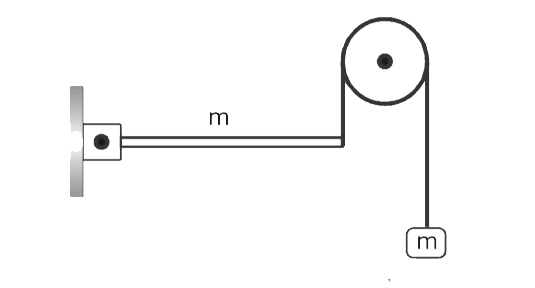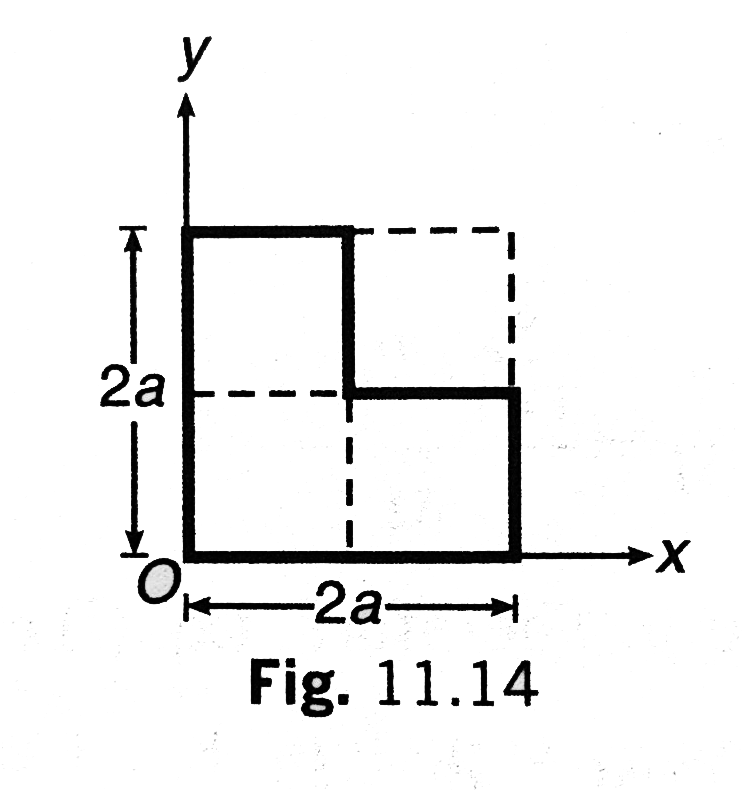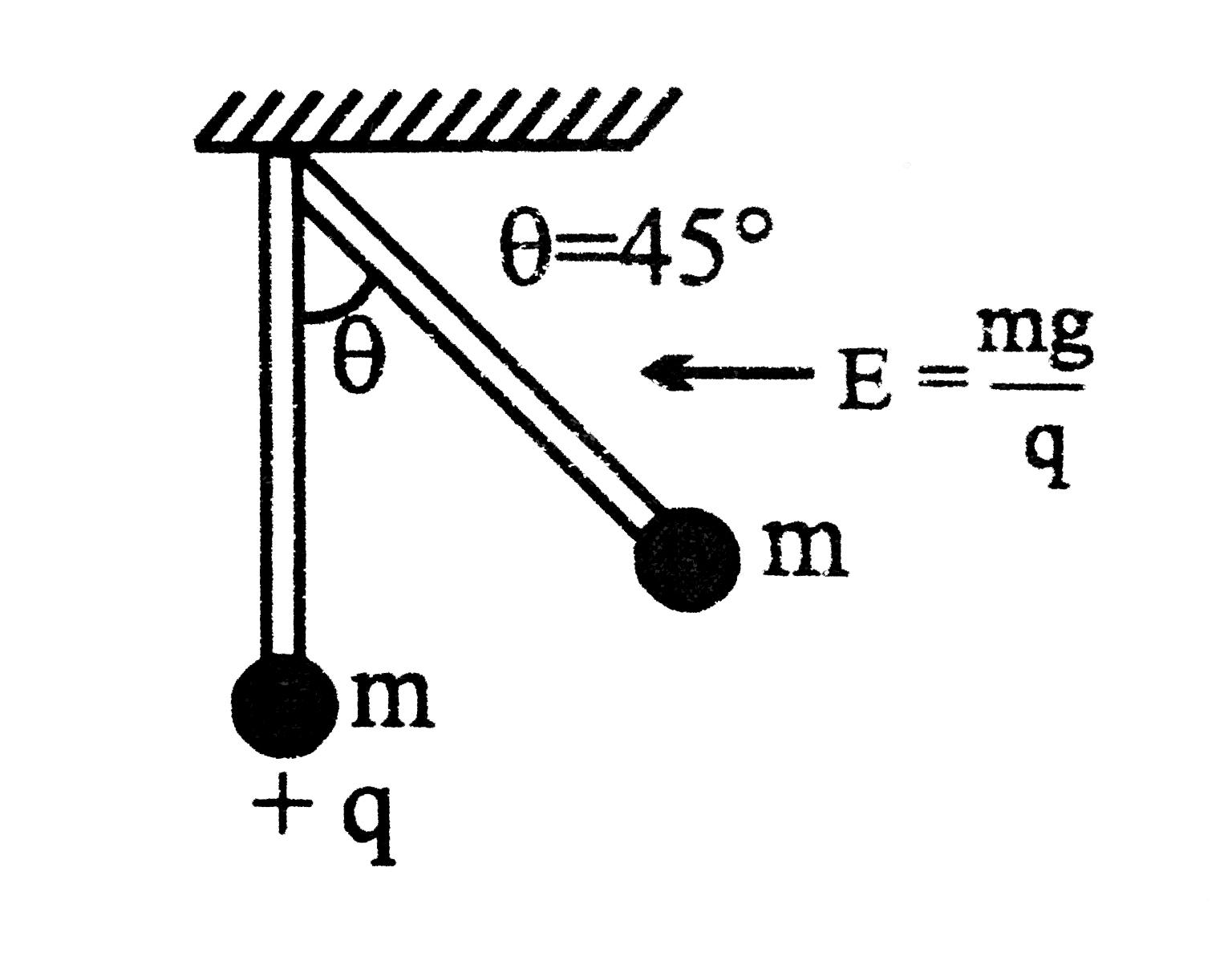A light rod carries three equal masses A, B and C as shown in figure. Find the velocity of B in vertical position of rod, if it is released from horizontal position. As shown in figure.

√2gl
√18gl7
√4gl3
√8gl7
d) Loss in PE = Gain in angular kinetic energy
or mgl3+mg(2l3)+mgl=12lω2………………(i)
Here, l= Moment of inertia about fixed point
= m(l3)2+m(2l3)2+ml2=149ml2
Form Eq (i),
2mgl=12(149ml2)ω2 ∴ ω=√36g14l
∴ vB=rw=2l3√36g14l = √8gl7)
Topper's Solved these Questions
- BOOK - BITSAT GUIDECHAPTER - ROTATIONAL MOTIONEXERCISE - BITSAT Archives9videos
ROTATIONAL MOTION
- BOOK - BITSAT GUIDECHAPTER - NEWTONS LAWS OF MOTION AND FRICTIONEXERCISE - BITSAT Archives23videos
NEWTONS LAWS OF MOTION AND FRICTION
- BOOK - BITSAT GUIDECHAPTER - SCALARS AND VECTORSEXERCISE - All Questions34videos
SCALARS AND VECTORS
Similar Questions
(a) In the system shown in figure 1, the uniform rod of length L and mass m is free to rotate in vertical plane about point O. The string an pulley are mass less. The block has mass equal to that of the rod. Find the acceleration of the block immediately after the system is released with rod in horizontal position.
(b) System shown in figure 2 is similar to that in figure 1 apart from the fact that rod is mass less and a block of mass m is attached to the centre of the rod with the help of a thread. Find the acceleration of both the blocks immediately after the system is released with rod in horizontal position.
 View Solution
View SolutionA uniform rod of length l and mass M pivoted about its end as shown in Fig. and is free to rotate in the vertical plane about the pivot. The rod is released from rest in the horizontal position.
(a) What is the initial angular acceleration of the rod?

(b) Find the initial acceleration of the right end of the rod?
( c) Find normal contact force due to hinge when rod has rotated through angle θ as shown in Fig.View Solution
Knowledge Check
- Question 1 - Select One or More
A simple pendulum A and a homogeneous rod B hinged at its enda are released from horizontal position as shown in figure.
 AThe times period of swing of simple pendulum is greater than that of rod If L=lBThe times period of swing of simple pendulum is equal to that of rod If L=lCThe times period of swing of simple pendulum is greater than that of rod If L=2l3DThe times period of swing of swing of simle pendulum is equal to that of rod if L=2l3
AThe times period of swing of simple pendulum is greater than that of rod If L=lBThe times period of swing of simple pendulum is equal to that of rod If L=lCThe times period of swing of simple pendulum is greater than that of rod If L=2l3DThe times period of swing of swing of simle pendulum is equal to that of rod if L=2l3 - Question 2 - Select One
A uniform rod of mass m and length l is fixed from Point A, which is at a distance l/4 from one end as shown in the figure. The rod is free to rotate in a vertical plane. The rod is released from the horizontal position.

What is the reaction at the hinge, when kinetic energy of the rod is maximum?A47B57mgC137mgD117mg - Question 3 - Select One or More
A conducting rod of length l is higed at point O. It is free to rotate in a vertical plane. There exists a uniform magnetic field →B in horizontal direction. The rod is released from the position shown in figure. Potential difference between the two ends of the rod is proportional to
Al3/2Bl2CsinθD(sinθ)1/2
A rigid massless rod of length 3l has two masses attached at each end as shown in the figure. The rod is pivoted at point P on the horizontal axis (see figuare). When released from initial horizontal position, its instantaneous angular acceleration will be
 View Solution
View SolutionA rod and a block are of same mass. Initially rod is in horizontal position. What will be acceleration of tip of the rod just after the system is released from this position shown in figure.
 View Solution
View SolutionFind the time period of mass M when displaced from its equilibrium position and then released for the system shown in figure.
 View Solution
View SolutionFind the position of centre of mass of the section shown in figure
 View Solution
View SolutionIn space of horizontal EF(E=(mg)/q) exist as shown in figure and a mass m is released at the end of a light rod. If mass m is releases from the position shown in figure find the angular velocity of the rod when it passes through the bottom most position
 .View Solution
.View Solution

